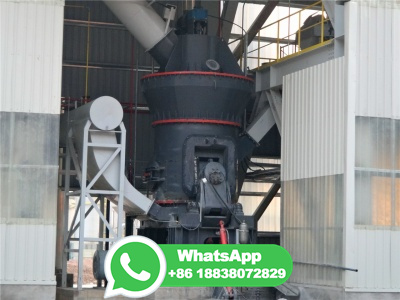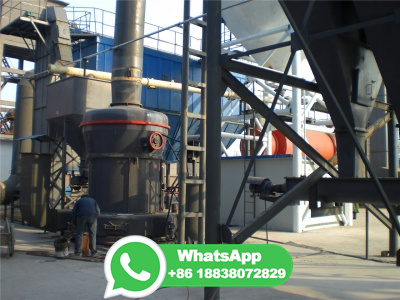
Sinter Making. The iron ore fines (− 10 mm) are agglomerated using Dwight Lloyed sintering machine. The iron ore fines and coke breeze fines mix with moisture is fed on the sinter bed which is ignited by a gas burner to initiate sintering process. The hot sintered ore is discharged at the end of the machine. The energy consumption ...
WhatsApp: +86 18037808511
Abstract. Sintering is the most economic and widely used agglomeration process to prepare iron ore fines for blast furnace use. In this chapter, the sintering process is first described to ...
WhatsApp: +86 18037808511
Iron ore sintering Chemistry Physical characteristics Mineralogy Granulation Densification Introduction Sintering is a thermal process of converting loose fine particles into a solid coherent mass by heat and/or pressure without fully melting the particles to the point of melting.
WhatsApp: +86 18037808511
According to the Environmental Protection Agency, the sintering process converts finesized raw materials, including iron ore, coke breeze, limestone, mill scale, and flue dust, into an agglomerated product, sinter, of suitable size for charging into the blast furnace.
WhatsApp: +86 18037808511
Iron making. The primary objective of iron making is to release iron from chemical combination with oxygen, and, since the blast furnace is much the most efficient process, it receives the most attention here. Alternative methods known as direct reduction are used in over a score of countries, but less than 5 percent of iron is made this way.
WhatsApp: +86 18037808511
Ore Sintering. The aim of the MEBIOS process is the formation of a ventilation route in the sintering bed by creating a lowdensity area around the large pellets arising from a kind of wall effect and suppression of sinter bed shrinkage due to support of the load by the dense large pellets in the upper part of the sinter bed. From: Iron Ore, 2015.
WhatsApp: +86 18037808511
Iron ore sinter is the result of a complex physicochemical reaction among the minerals present in the sinter mix in the sintering zone of heating and cooling. The precipitated mineral phases are influenced by maximum temperature reached, chemical composition, oxygen partial pressure ( p O 2 ), and cooling rate [ 2 ].
WhatsApp: +86 18037808511
During the iron ore sintering process trace elements can have four different destinations: remain in the sinter product, be retained by the abatement methods in the form of particulates, be emitted into the atmosphere as particulate material, or be emitted into the atmosphere in the gaseous form ( Xu et al., 2004 ).
WhatsApp: +86 18037808511
The sintering process produces iron ore agglomeration of size 1040 mm with better reducibility values than lumps. Utilization of a higher proportion of quality agglomerates in the burden increases the productivity of the blast furnace. The sintering process increases the productivity and reduces the requirement of fuel, flux, and operation time.
WhatsApp: +86 18037808511
A systematic analysis of industrial iron ore sinter product and associated sinter returns was undertaken. The samples were characterised through identification of the major macro and microstructural types present in these materials.
WhatsApp: +86 18037808511
Sintering is a thermal agglomeration process that is applied to a mixture of iron ore fines, recycled ironmaking products, fluxes, slagforming agents, and solid fuel (coke). The purpose of the sintering process is manufacturing a product with the suitable characteristics (thermal, mechanical, physical and chemical) to be fed to the blast furnace.
WhatsApp: +86 18037808511
The mathematical modeling of the iron ore sintering process has received much attention since the 1970s, when Muchi and Higuchi7) proposed the first one dimensional (1D) model. Fig. 1 is an attempt to explain how the sintering process can be treated as a one or a two dimensional (2D) process. The top left quadrant shows a side view of a steady
WhatsApp: +86 18037808511
The nontarget volatile organic compounds (VOCs) emissions from iron and steel industry, especially from the iron ore sinter process, may be an underappreciated index imposing a negative effect on the surrounding areas of China. Therefore, we appeal the authorities to pay more attention on VOCs emission from the iron and steel industry and ...
WhatsApp: +86 18037808511
Meanwhile, an iron ore sinter is a crucial material for the ironmaking process, and its chemical, physical, and metallurgical properties significantly impact the blast furnace (BF) performance. In turn, the main materials used for a sinter are iron ore fines, and their chemical compositions play a critical role in the sintering process. Due to ...
WhatsApp: +86 18037808511
Like other sintering processes, iron ore sintering converts iron ore fines of often − 8 mm sizing into larger agglomerates, namely, sinter, between 5 and 50 mm particle size, which possess the physical and metallurgical characteristics and gas permeability required for efficient blast furnace operation.
WhatsApp: +86 18037808511
Sintering Technology. 1. Sinter Making Technology Aritra Mallick AGM (Agglomeration) RDCIS, Ranchi. 2. Introduction During mining operation of Iron ore, big boulders are crushed to smaller size suitable for blast furnace charging. During this operation fines are generated and the same can not be discarded as it contains Fe to the tune of 60% ...
WhatsApp: +86 18037808511
Impact of Biopellet on Sintering Temperature Profiles. Figure 3 shows the temperature profile observed during iron ore sintering process at different proportions of biopellet. With an increase in biopellet the maximum temperature within the sinter bed reduces. In the presence of biomass, the water content required to granulate the sinter raw mix to a moisture levels of 8% increased from 8 ...
WhatsApp: +86 18037808511
Lowtemperature (< 1300 °C) iron ore sinter is an agglomerate of unmelted and partially melted nuclei particles (+ 1 mm) and a matrix bonding phase produced from the melting of fine ore (− 1 mm) and flux particles, with the majority of melt formation occurring in the granule adhering fines layer.
WhatsApp: +86 18037808511
This section describes sintering process, analyzes its characteristics, and introduces the carbon efficiency and thermal state parameters. Iron Ore Sintering Process. DwightLloyd sintering machine is adopted in sintering process, as shown in Fig. qualified sinter produced by the sintering process is utilized in the blast furnace process [].
WhatsApp: +86 18037808511
SYNOPSIS. Iron ore fines are agglomerated to produce sinter, which is an important feed material for blast furnaces worldwide. A model of the iron ore sintering process has been developed with the objective of being representative of the sinter pot test, the standard laboratory process in which the behaviour of specific sinter feed mixtures is evaluated.
WhatsApp: +86 18037808511
Iron ore pellets are small and hard spherical particles agglomerated from a fine iron ore concentrate. They are used in the blast furnace process to produce hot metal. The diameter of blast furnace pellets is usually between 8 and 16 mm. In this study, a batch of magnesia iron ore pellets was first sieved into particle sizes of 810 mm, mm, mm and 1620 mm, and the four ...
WhatsApp: +86 18037808511
Sinter is the first process in the whole ironmaking industry, which plays an important role in the iron and steel production process, and its energy consumption accounts for a large proportion of the entire ironmaking industry, reaching about 10%, which is the second largest energyconsuming process in the entire steel industry.
WhatsApp: +86 18037808511
Sintering process is a generic term that is used to describe the process of agglomeration of a green mix of iron ores, fluxes and coke and plant solid wastes having a particle size of 10 mm so as to produce sinter which can withstand operating pressure and temperature conditions existing in a BF.
WhatsApp: +86 18037808511
Sinter making is an intermediate step in valueadded chain for producing steel. Iron ore fines (−10 mm) is agglomerated to make it suitable blast furnace feed. In sintering process, ironore is partially reduced, and different fluxes are added to eliminate the undesirable elements in the slag.
WhatsApp: +86 18037808511